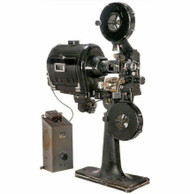35mm Projectors: The Unsung Heroes Shaping Cinema's Golden Era
Posted by Julio Urbay on 27th May 2025
The evolution of movie theaters is closely intertwined with the technology behind 35mm projectors. From their humble beginnings in the late 19th century to their golden era in the 20th century, 35mm projectors have been at the core of the cinematic experience for audiences around the world.
The Beginnings: Birth of Motion Picture Projection
The journey began in the 1890s when inventors and pioneers laid the groundwork for motion picture technology. Thomas Edison’s development of the Kinetoscope in 1891 marked one of the earliest attempts to capture and display moving images—albeit for individual viewing. Soon after, in 1895, the Lumière brothers introduced the Cinématographe in Paris. This portable device was revolutionary: it functioned as a camera, printer, and projector all in one, and it allowed films to be shown to an audience in a darkened room much like today’s movie theaters. These early innovations set 35mm film as the standard, a format that was solidified as the industry norm by 1909.
The Advent of the 35mm Standard
The transition to 35mm film was a pivotal moment for the industry and for moviegoers. With 35mm film offering a balance of image quality and practical handling, the format quickly dominated the burgeoning world of cinema. The introduction of innovations like the Latham loop—a mechanism that allowed film projectors to run smoothly for longer durations without tearing the film—ensured that early projectors met the practical demands of public screenings. These breakthroughs were instrumental in paving the way for more consistent and reliable public showings.
From Silent Pictures to Synchronized Sound
During its early years, the cinema experience was silent—relying on live musical accompaniment to enhance the storytelling. Filmmakers began to refine the art of visual storytelling, and projectors evolved to display increasingly longer films. The crucial step came in the late 1920s with the advent of synchronized sound. Systems like Vitaphone and later Movietone revolutionized movie projection by merging sound and image, forever changing the way audiences experienced films. This transition cemented the importance of robust 35mm projectors capable of handling both picture and sound seamlessly.
The Golden Age and the Projection Booth
As the film industry entered its Golden Age—from the 1930s to the 1950s—the technology of 35mm projection saw significant refinement. Projection rooms became more sophisticated, incorporating safety measures to handle flammable nitrate film stock until it was replaced by safer, non-nitrate alternatives in the fifties. The projection booth became a specialized space within the theater. Projectionists needed considerable training and skill, utilizing equipment that, by modern standards, required manual adjustments and keen attention to detail. These advancements not only improved the quality of film projection but also enhanced the safety and reliability of movie theaters.
Technological Innovations and Modernization
While the basic 35mm format remained the industry standard for decades, ongoing technological innovations gradually transformed projection equipment. Improvements in film processing, digital sound integration, and more robust mechanical designs allowed projectors to run longer with fewer interruptions. The evolution of projection technology set the stage for the eventual shift towards digital cinema, but 35mm projectors left an indelible mark on the history of film and continue to be celebrated for their craftsmanship and contribution to the cinematic arts.
Legacy and Impact
Even though many theaters today have transitioned to digital projection, the legacy of 35mm projectors is undeniable. They not only defined the visual language of movies for much of the 20th century, but they also established movie theaters as communal spaces for shared experiences. The artistry and mechanical ingenuity behind these projectors remain a testament to human creativity and innovation in the realm of film.
The history of 35mm projectors is a rich tapestry of technological advancements, creative storytelling, and societal transformation. From the early experiments of Edison and the Lumière brothers to the refined projection booths of Hollywood's Golden Age, 35mm projectors have illuminated the path for the magic of movies—and their impact continues to be felt in every frame viewed on the big screen.

